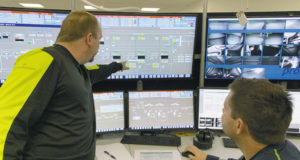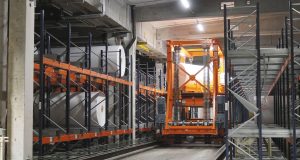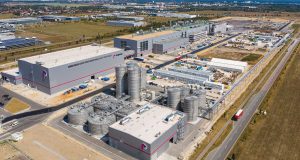Saving Money in Wastewater Treatment
This interview is an expansion of a short interview from the Paper360° podcast Better Together: Conversations with Innovative Leaders recorded at CorrExpo in August, 2023. Host Jan Bottiglieri speaks with Ron Gracy, territory manager, Walla Walla Environmental, about how corrugators can save money in wastewater treatment.
Paper360°: I think in the corrugated industry, wastewater treatment often gets overlooked because it’s not where you make money, it’s where you spend money.
Gracy: It is! It typically gets put over in the corner of the facility and forgotten about, and before you know it your plant is spending way more money than you ever wanted to. In reality, you want to be able to reduce your spending on waste treatment so you can put it back into your maintenance budget or other areas of the facility. We’ve saved upwards of US$400,000—in a single plant—for our customers. Some of these facilities are paying to haul water off every week because they can’t treat it.
That chemistry must be really complicated.
It can be. It can be very confusing to know where to start. “What are the first steps of this process? How do I share that with my employees?”—we get a lot of questions like that. The first step is just reaching out. There’s not a wastewater that we can’t treat.
That’s a pretty bold statement! But it’s a good question. When a new customer comes to Walla-Walla, where do you start?
We start with the water. Typically, we like to begin by figuring out what issues they’re having. Are they having chemical issues, mechanical issues? We take samples of their water back to our lab, and we work with it.
In fact, the single biggest mistake we see is customers not doing “jar testing.” Essentially, that means testing the water before you treat it. A lot of facilities have batches of 2,000, 3,000, even 6,000 gallons. We always recommend that our customers first do a sample-sized jar test of 400-500 milliliters, to find out how much chemistry will be needed to treat that 5,000-6,000-gallon batch.
There are a couple of reasons for this. The first one is that if you mess up a small cup of water, it’s not the end of the world; if you mess up 5,000 gallons, that will cost you thousands of dollars to have it hauled off. Jar testing helps our customers save money.
In addition, when a corrugated plant does multiple jar tests, it can show how much chemistry is actually needed for a specific batch to get the desired water clarity. A facility may regularly use 15 gallons of coagulant per batch, but a jar test determines that, for this batch, you may only need 8 gallons—or 20. A mill can end up with a lot of varying results for wastewater chemistry.
What can determine the variation from batch to batch?
Where the water comes from is a big issue. For instance, if there is well water coming into the facility, in some towns you’ll find calcium issues. Also, the different ink may have different effects; not all ink is made the same, and that can affect the wastewater.
It can even depend on the people on the floor. At home, we don’t typically think much about what goes down our drain. It’s the same thing with corrugated plants: when they’re dumping chemicals or ink into the pit, or even leaving a hose running, people are not really thinking about where it goes after that. They’re not thinking about the fact that it will always be the facility’s responsibility to treat that water.
We can provide water audits as a free service. We can come into the plant for a day or two and work with all the shifts and the management team. We look at how much water is being consumed—not only overall, but on each different machine. What are the different things we can do on each machine to mitigate water losses? What about ink waste? Not only will that impact how much chemistry is needed for waste treatment, it represents a cost for the customer in terms of ink consumption.
In fact, one of the most common issues I see is that plants aren’t using the last bit of ink in the bottom of the bucket; they’re just dumping it down the drain. That’s a lot of solids that will need to be treated. It’s two costs: the cost of treatment, and the cost of wasted ink.
Once a corrugated facility has done its testing, what’s the next step?
We then provide quotes for working with that plant’s water: i.e., how much a plant may want to spend, how much each chemical will cost. I can write up what that’s going to look like per week, per month, and per year. We then come back into the plant and provide a product trial. We treat the wastewater for them, providing all the chemistry. We work with them and show them what we do.
 ISTOCK.COM/HORSTBINGEMER
ISTOCK.COM/HORSTBINGEMER
What is the first sign in a corrugated plant that your wastewater system needs attention?
That varies from plant to plant. The biggest sign is that they’re trying to treat the water, but not getting clear water out of the system—they can’t get the system to do what they need it to do.
Another red flag is if a plant has been using 20-30 gallons of chemistry on average over the past two years, and now suddenly it’s using 60. It doesn’t even need to be that drastic. Any uptick can be a sign something has changed. I’ve seen a lot of that since COVID. There has been high turnover in some plants, with new operators and people who might be taking shortcuts.
We had one customer that had an employee who’d been working there a long time. He ran their wastewater system. Suddenly, he retired, and they were left with nobody. We were able to go into that facility and work with them until they had their system back and running, so they didn’t need to haul off wastewater—because those costs can be enormous.
That “brain drain” can be a real problem within the corrugated industry. Is that something you can help with?
Absolutely. We can do training—either one-on-one, or in a classroom setting. If there’s anyone who wants to know more about how wastewater treatment works, we are happy to work with them.
We always recommend having at least one backup trained. We can train a plant’s primary operator, plus any backups or management, if they’re interested in knowing the process.
What are some specific issues you find with corrugated industry customers that make them different from, say, agriculture or food processing customers?
I think the most common challenge for corrugators is that there seems to be a myth floating around that the only thing you need to clean your corrugated lines with is bleach or hot water. What ends up happening is that the lines get clogged, limiting the inner diameter. It then costs thousands to replace the lines.
They could be using a product like CleanTankHP to clear those lines and get them back to their normal process. CleanTank HP is one of our best products. It does a really good job of cleaning out those starch lines—not just cleaning them, but killing any bacteria in them. It’s a granular product that is mixed into the starch tanks and is then recirculated through the lines over the course of five or six hours. While it’s moving through the system, it pulls that buildup off the lines. It doesn’t require heat or pressure to work.
What is one thing you wish your corrugated customers knew when it comes to saving money in wastewater treatment?
If you’re having issues, reach out. There’s always someone out there who can help.
It’s very fulfilling when I go into a facility having a lot of issues … and then I’m able to watch the stress disappear from their faces. A lot of corrugated plant managers are so busy; they have a thousand and one tasks a day, and wastewater treatment is just one more thing gnawing at the back of their head. To be able to go into a plant and work with them, take that load off their minds and make it better… it’s great.



